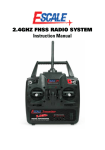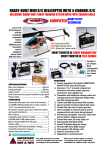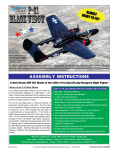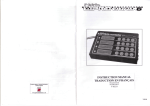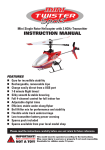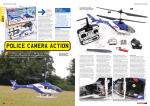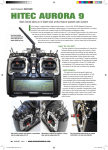Download AirTek AT90 Specifications
Transcript
Brushless powered Glider factory fitted 2.4GHz Radio ASSEMBLY INSTRUCTIONS ELECTRAGLIDE SPECIFICATIONS Wingspan: Length: Weight (without battery): Battery: Power: Radio Control: Flight time: 1520mm (61”) 920mm (36”) 555g (18oz) 7.4V 1500mAh 12C LiPo Brushless Motor 1050KV EScale 2.4GHz/5ch Up to approx. 15 minutes CONTENTS VITAL SAFETY INFO weee disposal .................................................................. 2 Vital safety info ............................................................... 2 About the flying area required ...................................... 2 Training, crashes & spares ............................................ 2 important notice............................................................... 2 Guarantee/warranty ........................................................ 2 Kit contents ....................................................................... 3 NiMh battery safety......................................................... 4 Nimh flight battery ........................................................... 4 Charging the flight battery .......................................... 5 Assembling the ElectraGlide ........................................ 6 Switch on the transmitter .............................................. 8 Prepare for flight .............................................................. 9 Flycamone eco instructions ........................................ 10 Transmitter layout.......................................................... 12 Mode II transmitter layout ........................................ 12 Mode I transmitter layout ......................................... 12 Pairing the esc and transmitter .................................. 12 Control checks ............................................................... 13 Preflight checks ............................................................. 14 Flying................................................................................ 15 Take-off ........................................................................ 15 Landing......................................................................... 15 CAUTION! The ElectraGlide is not a toy. It can cause injury to persons/animals and/or property if not used correctly. It is unsuitable for persons under the age of 14. You should take care and observe the principles of safety when flying this model. In the UK, we recommend you observe the British Model Flying Association (BMFA) safety code at all times, which can be found at the following address: http:// www.bfma.org In Australia, please contact your hobby supplier or the Model Aircraft Association of Australia (MAAA). YOU ASSUME ALL RISK. Before beginning construction, please read this document thoroughly and familiarize yourself with the construction sequence of the ElectraGlide. If any information in this manual is unclear, please contact your supplier for help. After reading this manual store it in a safe place for future reference. This kit is a beginner-intermediate model, basic RC flying knowledge and skills are required. Warning: You must not use the camera for an illegal purpose. You should carefully check all applicable laws in your area to ensure that you do not breach any criminal or civil laws when using or operating the camera and/or publishing any images. Videos and photographs should not be taken or published without appropriate consent of any person or company shown in any photographs or images. Particular care must be taken to ensure that you do not breach any civil or criminal laws relating to issues such as privacy, voyeurism, confidentiality, stalking and harassment, aviation and airports, national security, nuisance and trespass. You are solely responsible for your actions. Neither J Perkins Distribution Ltd/Model Engines (Aust.) Pty. Ltd. nor its distributors shall be responsible for any liability or breach of the law associated in any way relating to the use of this product. ABOUT THE FLYING AREA REQUIRED If you are a newcomer to R/C flight and have never flown a radio control model before; it is vital you seek advice from an experienced model pilot on where and how to fly. Only fly in large open spaces that are approved for R/C model flying and that are away from people, animals, buildings, power lines, water or trees. Only fly in bright sunny conditions where wind speed does not exceed 5mph. TRAINING, CRASHES & SPARES The ElectraGlide has been designed to be strong and very easy to repair, however, it is not invulnerable and most people will break parts during their flying career. This is quite normal. All parts are available as spares from your supplier. Crash damage is not covered by warranty. IMPORTANT NOTICE Please read the manual. WEEE DISPOSAL Do not dispose of this product with other household waste. Instead, it is your responsibility to dispose of your waste equipment by handing it over to a designated collection point for the recycling of waste electrical and electronic equipment. The separate collection and recycling of your waste equipment at the time of disposal will help to conserve natural resources and ensure that it is recycled in a manner that protects human health and the environment. For more information about where you can drop off your waste equipment for recycling, please contact your local council, your household waste disposal service or the shop where you purchased the product. GUARANTEE/WARRANTY J. Perkins Distribution Ltd guarantee this product to be free of manufacturing and assembly defects for a period of one year from time of purchase. In Australia, the Model Engines (Aust.) Pty. Ltd. manufacturers warranty period is for 30 days. This does not affect your statutory rights. This warranty is not valid for any damage or subsequent damage arising as a result of a crash, misuse, modification or for damage or consequential damage arising as a result of failure to observe the procedures outlined in this manual. Operation of this model is carried out entirely at the risk of the operator. Please note that, whilst every effort is made to ensure the accuracy of instructions and material included with this product, mistakes can occur and neither J. Perkins Distribution Ltd/Model Engines (Aust.) Pty. Ltd. nor it’s distributors will be held liable for any loss or damage arising from the use of this model or for any loss or damage arising from omissions or inaccuracies in the associated instructions or materials included with this product. We reserve the right to modify the design of this product, contents and manuals without prior notification. © 2010 J Perkins Distribution Ltd, Lenham, Kent, UK ME17 2DL. www.jperkinsdistribution.co.uk Model Engines (Aust.) Pty. Ltd., Noble Park, Victoria 3174, Australia. www.modelengines.com.au. All rights reserved. E&OE. 2 ElectraGlide Instruction Manual KIT CONTENTS CONTENTS LIST 1 2.4 GHz 5ch EScale Transmitter 1 Fuselage with 2.4 GHz receiver, 4x 9g Servos, Brushless motor 1050KV, 18A ESC, Folding Propeller and Spinner 2 Main Wing halves with Servos installed (left and right) 1 Wire Wing Spar 1 Horizontal Tail 1 Fin and Rudder 1 2-Cell 7.4V 1500mAh 12C LiPo Battery 1 Battery Charger 1 Leads for Battery Charger to connect to 12V battery 1 Mains power supply for charger ADDITIONAL ITEMS REQUIRED 8 x AA Transmitter batteries ELECTRAGLIDE SPARE PARTS LIST JPEG001 JPEG002 JPEG003 JPEG004 JPEG005 JPEG006 JPEG007 JPEG008 JPEG011 JPEG014 JPEG015 JPEG016 ElectraGlide Instruction Manual Fuselage -ElectraGlide Main Wing - ElectraGlide Wing Joiner Rod - ElectraGlide (6 x 402mm) Elevator and Horn - ElectraGlide Rudder and Horn - ElectraGlide Motor Mount Set - ElectraGlide) Brushless Motor - ElectraGlide (2830) 18A ESC (Brushless Speed Controller) 7.4V 1500mAh LiPo Battery - ElectraGlide 9.2 X 7 Prop and Spinner - ElectraGlide Spinner - ElectraGlide Prop Adaptor - ElectraGlide 3 LITHIUM POLYMER FLIGHT BATTERY The Lithium polymer (Li-po) flight battery is a high power battery designed to give a flight time of up to 10 minutes per charge. It is supplied in a partially charged state. As well as a red T-Plug power lead, the battery is also fitted with a white 3-pin polarised connector. This is the charge lead. When you have finished flying for the day, recharge the battery and always leave it in a partially or fully charged state. Never leave your battery in a discharged state as this may damage the battery and shorten it’s life. If you notice the ElectraGlider is losing power, land and recharge the battery. Do not be tempted to run the battery past this stage as you will be over-discharging and the battery may be damaged. WARNING! We recommend that you use only the supplied charger with this battery. WARNING! Over-discharging will shorten the life of the battery or damage it. WARNING! Do not short circuit—battery may explode! PLEASE READ THE SAFETY PROCEDURES FOR HANDLING LI-POLY BATTERIES BELOW BEFORE PROCEEDING FURTHER. LITHIUM POLYMER BATTERY SAFETY Before Charging Li-po’s ■ Before charging your battery check for any damage e.g. check if the battery has expanded or swollen in size or if the battery cells have been punctured. If any of the above is true: DO NOT CHARGE THE BATTERY! Charging Li-po’s ■ Only use a charger designed to charge Lithium polymer batteries. Never use a nicad or other charger as this is very dangerous. ■ Never attempt to charge at a rate faster than that recommended in the instructions. Check that the battery cell count matches the charger cell count switch (if fitted). ■ Never charge unattended. Always stay with your battery whilst charging in case of overheating or fire. ■ Charge on a safe surface or container (e.g. old unused microwave oven). Charge only on non-flammable surfaces, e.g. concrete floor preferably outdoors, or in a pyrex cooking dish with the battery placed on a bed of sand, or in a fireplace. Never charge inside a car! ■ Switch off charger if battery gets too hot. If the battery becomes hot to the touch during charging, disconnect and switch off immediately. ■ Extinguish fires with sand. If something goes wrong and your battery catches fire, always have sand from a fire bucket at hand to douse the flames. Do NOT use water! Using Li-po’s ■ Do not modify/change any part of the battery or lead. Do not remove its heat shrink protective covering. Removal or modification may damage the battery and will invalidate any warranty claim. ■ Do not place this battery near fires or anything with high temperatures. ■ Do not charge batteries while you are driving and do not store batteries in any type of motor vehicle. ■ Do not let the battery get wet or become submerged in any type of liquid. ■ Do not carry loose batteries in your pocket or bag as they could short-circuit against other items. ■ If you should get electrolyte from the cells on your skin, wash thoroughly with soap and water. If in your eyes, rinse thoroughly with water. Seek medical assistance. 4 ElectraGlide Instruction Manual CHARGING THE FLIGHT BATTERY Li-Po battery Mains power supply for charger DC power leads Li-Po charger The charger is designed to automatically charge the Li-Po battery in about 1 hour from a discharged state. The 12V DC automatic charger is powered by the mains power supply illustrated above. Alternatively, you can use a 12 volt sealed modelling battery to power the DC automatic charger.. 1. Connect the mains power supply to your wall socket and the other end to the charger. The LED on the charger will glow GREEN showing power is available.. 2. Insert the white JST plug attached to the battery into the white socket on the charger. Make sure it is fully connected. Charging: Whilst charging LED flashes RED Fully charged: Fully charged LED is solid GREEN. 3. When the battery is fully charged disconnect the battery from the charger. Disconnect the power supply from charger and the wall. Your LiPo battery is ready for use 4. Alternatively you can connect the charger to a 12V lead acid battery or 12V switched power supply using the supplied lead. ElectraGlide Instruction Manual 5 ASSEMBLING THE ELECTRAGLIDE 5. Locate and test fit the horizontal stabilizer and elevator to the fuselage. 6. Peel the proctective strip off the double sided tape and carefully fit the horizontal stabilizer and elevator to the fuselage. Alternatively, remove the double sided tape completely and glue the horizontal stabilizer in place using 5-15min epoxy. 7. Locate the vertical fin and rudder and test fit on the fuselage making sure the hinge on the rudder fits into the slot on the end of the fusleage (inset picture). 8. Peel the proctective strip off the double sided tape and carefully fit the vertical fin and rudder to the fuselage. Alternatively, remove the double sided tape completely and glue the horizontal tail in place using 5-15min epoxy. 9. Check your alignment. The vertical fin should be at 90 degrees to the horizontal stabilizer. Tip - To aid with alignment you may prefer to fit the wings first prior to attaching the horizontal stabilzer and vertical fin. 6 ElectraGlide Instruction Manual 10. Connect the clear clevises to the elevator horn and rudder horn. Push the ends of the clevises firmly together to prevent them coming off in flight. Beginners should use the outside hole on the horn. More advanced flyers can use the inner holes to increase control throws and sensitivity. 11. Locate the wire wing spar. This will be installed with the ends pointing up as shown. 12. Feed the wing spar through the plywood plate in the fuselage with the ends pointing up. 13. Slide the wing panels onto the wire wing spar making sure the ends of the wire are pointing up not down. Connect the elevator servo lead in each wing to the matching leads in the fuselage. ElectraGlide Instruction Manual 7 14. This picture shows the wings with wire wing spar in place and servo leads connected 15. Slide one of the wing panels all the way into the fusleage making sure the centre of the wire wing spar stays in place and the ends of the wire are pointing up. 15. Slide one other wing panel all the way into the fusleage making sure the other wing stays in place. 16. Check the aileron pushrods and clevises are firmly attached. Beginners should use the outside hole on the aileron horn. More advanced flyers can use the inner holes on the aileron horn to increase control throws and sensitivity. 8 ElectraGlide Instruction Manual 17. To futher reduce sensitivity the wire may be moved to the inner holes of the servo horns. (Shown here on the elevator servo) (Use a phillips head screw driver to remove the servo horn screw, pull off the servo horn, change the position of the wire and replace the servo horn and screw.) 18. The wings should angle up (positive dihedral) and the horizontal stabilizer and vertical fin should line up like shown in this picture. The better the alignment, the easier and better the ElectraGlide will fly. 19. The Electraglide is now fully assembled, 19. The model has been set up to balance out of the box without the need to add nose or tail weight. The Centre of Gravity or CofG for the ElectraGlide is 50mm back from the leading edge of the wing measured at the wing root (where the wing meets the fuselage). ElectraGlide Instruction Manual 9 SWITCH ON THE TRANSMITTER 21. The ElectraCam comes with an EScale 2.4GHz. Transmitter. 22. Install 8-AA batteries (sold separately) into the battery compartment located in back of Transmitter case. 23. PLEASE READ THIS Always turn your transmitter ON before you turn your plane on. Always turn your plane OFF before you turn your transmitter OFF. Note: Ensure the throttle stick and trim slider are in the down position (mode 1 shown). The other trim sliders should all be centered as shown. 24. Turn on the transmitter by pushing the ON/OFF sliding switch forward.. 10 ElectraGlide Instruction Manual PREPARE FOR FLIGHT 25. After turning ON the transmitter, remove the canopy of the ElectraGlide and place the ground. Locate the charged battery and also take note of the white velcro patch on the bottom of the battery. Note: Double check your transmitter is ON. 26. Connect the RED plug from the battery to the RED plug from the ESC in the ElectraGlide fuselage. You should hear the servos come to life Note: If the servos do not come to life unplug the battery, wait a few seconds and try again. 27. Secure the battery in the position shown using the velcro on the battery and the preinstalled velcro in the fuselage. 28. Replace the canopy. ElectraGlide Instruction Manual 11 TRANSMITTER LAYOUT MODE 2 TRANSMITTER LAYOUT 29. Left Stick is Throttle (up and down) and Rudder (side to side) 30. Right Stick is Elevator (up and down) and Ailerons (side to side). 31. 32. Servo reversing switches across lower front of case. 33. Fine trim adjustments for 4 main channels. Please see the EScale Transmitter Manual for more detailed instructions on Transmitter functions Elevator Down Throttle High Rudder Left Rudder Right Ailerons Elevator Up Throttle Low Power Switch Trim Adjustments MODE I TRANSMITTER LAYOUT 34. Left Stick is Elevator (up and down) and Rudder (side to side) 35. Right Stick is Throttle (up and down) and Ailerons (side to side). 36. 37. Servo reversing switches across lower front of case. 38. Fine trim adjustments for 4 main channels. Please see the EScale Transmitter Manual for more detailed instructions on Transmitter functions Ch. 5 switch (Not used on ElectraGlide) ‘PDM’ Switch Servo reverse switches Ch. 5 switch (Not used on ElectraGlide) ‘PDM’ Switch Throttle Up Elevator Down Rudder Left Rudder Right Ailerons Throttle Down Elevator Up Power Switch Trim Adjustments Servo reverse switches PAIRING THE ESC AND TRANSMITTER 39. PLEASE NOTE: The first time that the model is powered up the ESC must recognize the transmitter and verify the range of throttle motion. Follow these easy steps. 40. With the throttle stick at its lowest position, turn on the transmitter and then plug the flight battery into the ESC. Note: Photo shows a Mode 2 transmittter 41. After a few seconds there will be a beep tone, move the throttle stick to full throttle, there will be another beep tone but the motor will not start. 42. Return the stick to its lowest position for the final confirmation tones after which the throttle will work normally. 43. Please note that this process only needs to be done one time. After this the throttle will operate normally for all subsequent flights. 12 ElectraGlide Instruction Manual CONTROL CHECKS 44. Elevator is controlled by the elevator stick. Check that the direction and distance of movement is correct. 45. Stick toward the bottom of the transmitter the elevator should move up. When moved toward the top of the transmitter the elevator should move down. 46. If the direction is incorrect, switch the servo reversing switch CH2 on the front of the transmitter. 47. Adjust the position of the clevises on the servo and horn to get approx. 10mm in each direction measured at the trailing edge. Note: Check that rudder trim is centered. Neutral Elevator 48. Rudder is controlled by the rudder stick. Check that the direction and distance of movement is correct. Stick to the right, rudder should move to the right and stick to the left, rudder should move to the left. 49. If the direction is incorrect, switch the servo reversing switch CH4 on the front of the transmitter. 50. Adjust the position of the clevises on the servo and horn to get approx. 15mm movement in each direction measured at the trailing edge. Note: Check that rudder trim is centered. Neutral Rudder ElectraGlide Instruction Manual Up Elevator Down Elevator Right Rudder Left Rudder 13 51. Ailerons are controlled by the aileron stick. Moving the stick to the right, the right aileron should come up and the left aileron should go down. Moving the stick to the left, the left aileron should come up and the right aileron should go down. 52. If the direction is incorrect, switch the servo reversing switch CH1 on the front of the transmitter. 53. Adjust the position of the pushrod to get approx. 10mm movement in each direction measured at the trailing edge. Note: Make sure aileron trim is centred. 14 Neutral Aileron Left Aileron (up) Right Aileron (down) Left Aileron (down) Right Aileron (up) ElectraGlide Instruction Manual PREFLIGHT CHECKS If you are new to flying R/C aircraft, or even an experienced modeller, we recommend you have a fellow R/C modeller help you with the first flight. Some items you will need to complete on your first preflight are: 1. Aircraft assembled correctly and ready for flight. 2. All control throws are set per this manual. 3. Transmitter battery power is good. 4. Flight Battery is fully charged and secure. 5. All electronics are operating correctly, proper direction, and secure. 6. Wait for a calm or light wind day for first flights. 7. If you are new to R/C flying, consider having an accomplished flyer make the first flight and trim the aircraft FLYING Ask another person to launch the ElectraGlide into the wind horizontally with the nose slightly up, but no more than 15 degrees. Smoothly advance the throttle. After a few feet apply a small amount of up elevator and the model will begin to climb. Continue to climb out at a shallow angle until you reach an altitude of 75 to 100 feet and level off. Adjust the flight surface trims until the model flies wings level without a tendency to climb or dive. When making a landing approach a small amount of throttle should be maintained. Moving the throttle to the down position while flying will prolong the flight as the model has a very good glide angle. When you need more height, move the throttle to the up position. When you are ready to land, move the throttle to the down position and glide into the wind to land. We hope that you enjoy your ElectraGlide as much as we do. TAKE-OFF LANDING ElectraGlide Instruction Manual 15 Brushless powered Glider factory fitted 2.4GHz Radio Australasian agents: European agents: Model Engines, Melbourne, Australia J Perkins Distribution, Lenham, England www.modelengines.com.au www.jperkinsdistribution.co.uk American agents: Hobby Lobby International, Brentwood, Tennessee, U.S.A. www.Hobby-Lobby.com June 2010
















